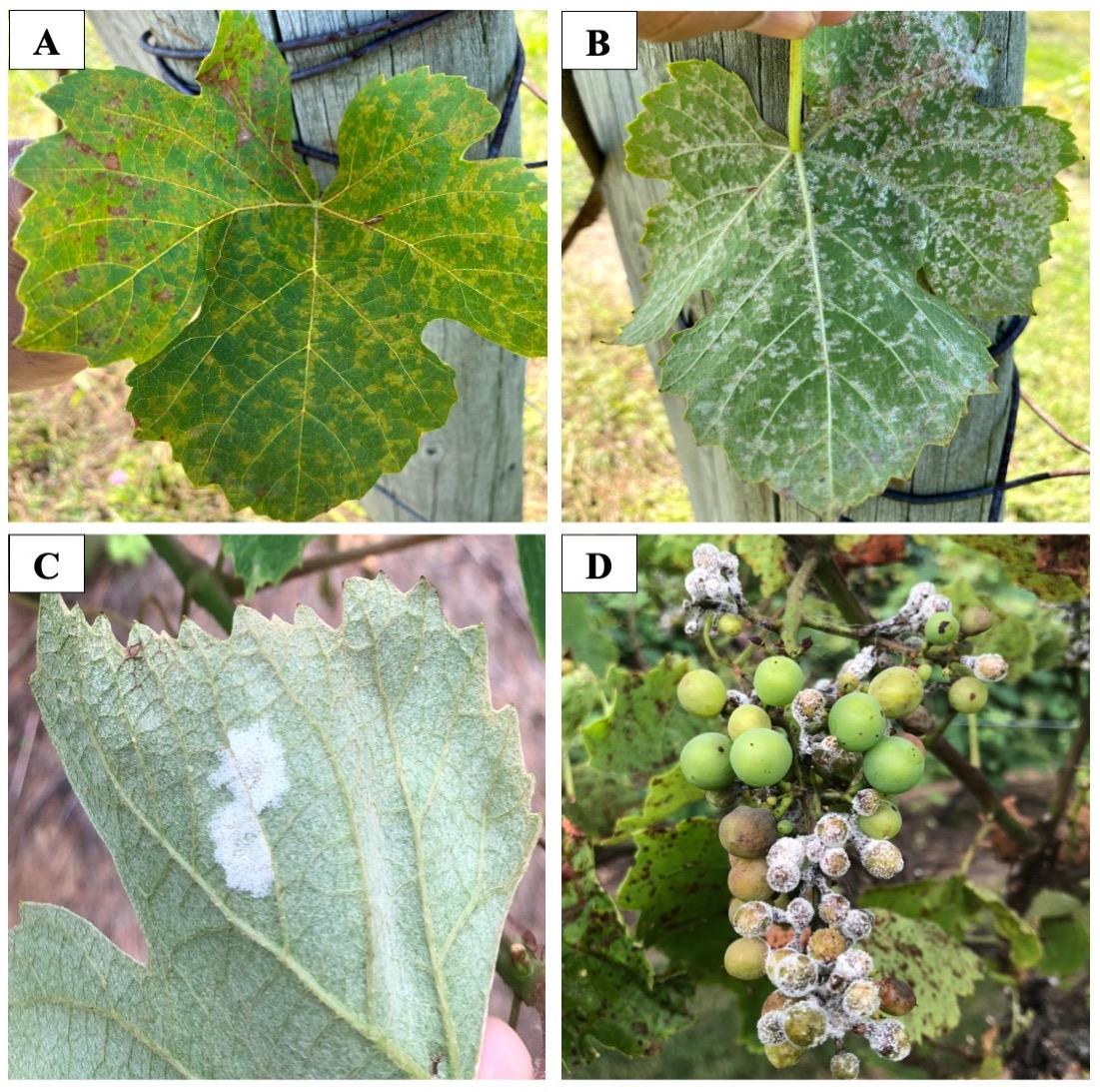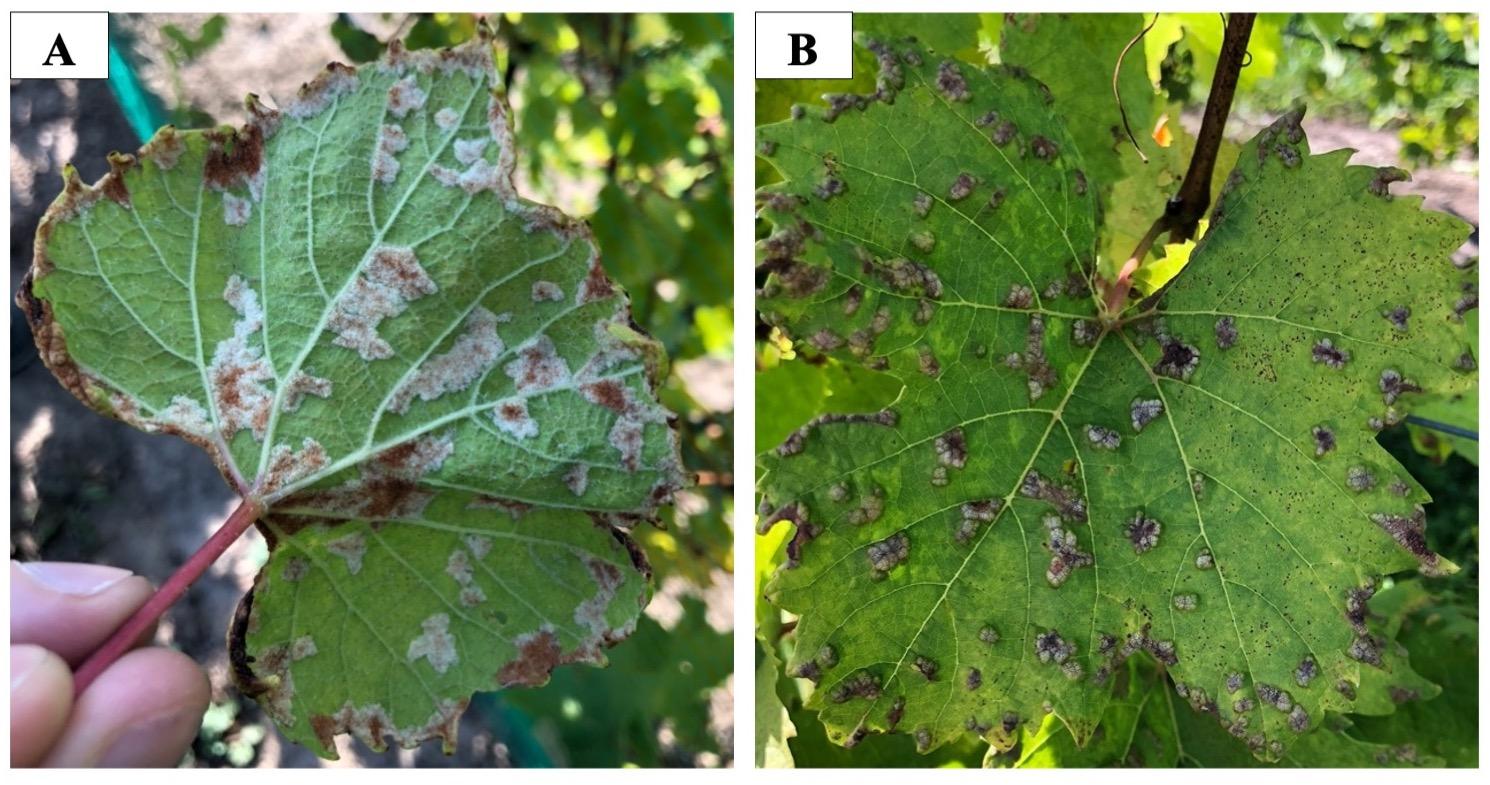
Michigan Grape Facts: Managing Grapevine Downy Mildew
DOWNLOADAugust 24, 2023 - Nancy Sharma, Esmaeil Nasrollahiazar, Laura Miles and Timothy Miles
Key messages
Resistance – choose resistant varieties when possible.
Protection – protect flowers and leaves with fungicides when the infection risk is high and limit excess irrigation to reduce canopy humidity.
Eradication – eradicate downy mildew with multisite products if there is significant sporulation as this will reduce overwintering inoculum.
Pathogen
Plasmopara viticola
Kingdom: Chromista
Phylum: Oomycota
Order: Peronosporales
Introduction
Grapevine downy mildew caused by Plasmopara viticola is a persistent and destructive disease that poses a significant threat to grape growers. To effectively manage this disease, it is crucial to implement practical strategies and adopt sustainable vineyard practices. By prioritizing sustainability, vineyard owners can protect their grapevines while minimizing the use of fungicides and reducing the risk of resistance development. In this article, we will explore integrated grapevine downy mildew management strategies, encompassing good vineyard practices, biological control, and the avoidance of fungicide resistance.
Disease signs and symptoms
Downy mildew symptoms can be seen on all green parts of the grapevines. Usually, the symptoms are first observed on the leaves five to 17 days after infection. Foliar symptoms include green to yellow circular spots that appear like oil spots (Figure 1A). Under optimal conditions, several oil spots may develop and merge to cover larger areas of the leaf. Warm and humid nights can lead to white fussy growth (sporangia) on the underside of the infected leaf or other plant parts (Figure 1B, 1C, 1D). Later, the lesions turn brown as the infected tissue dies. Severe infections can lead to premature defoliation (Figure 2). Infected inflorescences can dry up completely and get covered with white sporangia. Young, infected berries change color to dull green or reddish brown and may either die or become discolored. Eventually, these berries can also be covered with white sporangia (Figure 1D). Within three weeks after bloom, berries develop resistance to the pathogen. However, the rachis remains susceptible for several weeks.

Disease cycle
To achieve proper downy mildew management, it is essential to understand the disease cycle. This pathogen overwinters as resting spores (known as oospores) on fallen leaves in the soil. Spores are released from decaying leaves in the vineyard starting in spring. Oospores germinate after bud break with rain events of at least 10 millimeters (0.04 inches) and temperatures above 10 degrees Celsius. Oospores serve as the primary inoculum and when germinating produce a single germ tube, which terminates in a sporangium. The sporangium releases zoospores once in contact with water. Rain-splashed zoospores also germinate by producing a germ tube and enter the lower surface of leaves through the stomata. Once plant tissues are colonized, more sporangia emerge on the underside of infected tissues. This secondary inoculum allows the disease to spread further with the wind or rain onto healthy new shoots, leaves and clusters. Infections usually occur in the morning hours as five to seven hours of sunlight exposure can inactivate sporangia. The optimal temperature for disease development is 18 to 25 C (64 to 76 degrees Fahrenheit), with minimum temperature 10 C (50 F) and maximum temperature 30 C (86 F). The nights with high humidity and temperature above 13 C (55 F) favors disease development and sporangia production.

Scouting and monitoring
Regular scouting and monitoring are essential for early detection of downy mildew symptoms and timely intervention. By following these practical tips, growers can effectively scout for downy mildew and ensure sustainable disease management:
Visual inspection: Regularly examine leaves, shoots and clusters after bloom for symptoms of downy mildew. Look for yellow "oil spots" on the upper surfaces of leaves and the presence of white, cottony sporulation on the undersides.
Timely intervention: If the presence of downy mildew is confirmed, apply a fungicide with post-infection and anti-sporulant activity as soon as possible. Timely intervention can prevent further disease spread and minimize the need for extensive fungicide applications.
Recordkeeping: Maintain detailed records of disease severity and location in the vineyard. This information can aid in future decision-making and treatment strategies, leading to more sustainable and targeted management practices.

Integrated disease management
Cultural control
To promote integrated disease management, it is crucial to focus on preventive measures and cultural practices that minimize the reliance on fungicides. Implementing the following practices can reduce the initial inoculum and create an unfavorable environment for the pathogen that will slow down the spread of the disease.
Site selection: Choose vineyard sites with well-drained soils, good air circulation and sunlight. Proper site selection contributes to sustainable downy mildew management by reducing the disease pressure.
Dormant season practices: It is essential to remove plant debris from vineyards during fall to reduce the amount of the overwintering spores. Shredding, burying or removing plant debris can significantly reduce the inoculum for the upcoming season.
Vineyard management: Positioning shoots properly and practicing leaf pulling can promote vine drying and reduce humidity, which hinders downy mildew development.
Biological control
Biological control utilizes natural enemies of the pathogen to suppress disease development. Beneficial microorganisms, such as specific strains of bacteria and fungi, can be used to suppress downy mildew. These microorganisms can colonize the grapevine surfaces, competing with the pathogen for resources and inhibiting its growth. Certain antagonistic organisms, such as Bacillus mycoides, Trichoderma spp. have shown potential in controlling downy mildew. Market available bioproducts can also be used as a preventative measure to manage the disease. Integrating biological control methods into disease management can enhance disease suppression while promoting a more environmentally friendly approach.
Resistant varieties
Planting grapevine varieties that exhibit natural resistance to downy mildew can provide sustainable long-term management. Resistant varieties can reduce the disease pressure and minimize the need for fungicide applications. Fully resistant cultivars are not available; however, less susceptible cultivars to downy mildew are available (Table 1).
|
Table 1. Tolerance level of various grape cultivars to downy mildew. |
|||
|---|---|---|---|
|
Slightly susceptible |
Moderately susceptible |
||
|
Alden |
Alwood |
Alpenglow |
Aurore |
|
Baco Noir |
Bluebell |
Buffalo |
Canadice |
|
Beta |
Brianna |
Caco |
Chambourcin |
|
Cascade |
Chelois |
Cayuga White |
Cynthiana |
|
Colobel |
Concord |
Chardonel |
Dutchess |
|
Concord Seedless |
Edelweiss |
DeChaunac |
Einset Seedless |
|
Foch |
Frontenac |
Elvira |
Geneva Red-7 |
|
Frontenac Gris |
Interlaken |
Esprit |
Golden Muscat |
|
Horizon |
Himrod |
Glenora |
Jupiter |
|
Isabella |
Einset Seedless |
La Crescent |
Leon Millot |
|
Landot 4511 |
Kay Gray |
Landot 4511 |
Melody |
|
Glenora |
King of the North |
Louise Swenson |
Noiret |
|
Lakemont |
La Crosse |
Neptune |
NY81.0315.17 |
|
New York Muscat |
Marchal Foch |
NY76.0844.24 |
Seyval |
|
Marquette |
Moore’s Diamond |
Rosette |
St. Vincent |
|
Prairie Star |
Ravat 34 |
St. Croix |
Traminette |
|
Sangiovese |
Seneca |
Swenson white |
Ventura |
|
Sheridan |
St. Pepin |
Vanessa |
Vignoles |
|
Steuben |
Suffolk red |
Venus |
Villard blanc |
|
Sunbelt |
Villard noir |
Vidal blanc |
|
|
Valvin muscat |
Vincent |
|
|
|
Worden |
Sabrevois |
|
|
Chemical control
While sustainable grapevine downy mildew management aims to minimize fungicide usage, there are instances where fungicides are necessary. Adopting preventative fungicide practices can help reduce the risk of resistance development and promote long-term effectiveness. Consider the following guidelines:
Timing of fungicide applications: Initiate protectant fungicide sprays when shoots reach 2.5 to 5 centimeters (1 to 2 inches) in wet springs or no later than the pre-bloom stage. Early timing can effectively prevent primary infections and reduce disease severity.
Recommended fungicides: Downy mildew can be managed using fungicides in three phases.
Phase 1: Protectants multisite fungicides such as Mancozeb, Captan, Ziram and copper can be used early in the season. Protectants fungicides are required to be applied at regular intervals as they provide protection only for short span and do not move inside the plant. These tend to be the most cost-effective products and have activity on other diseases like black rot and Phomopsis cane and leaf spot.
Phase 2: When environmental conditions are favorable for downy mildew, site-specific fungicides should be used. Some products have been shown to be curative for downy mildew. Several site-specific fungicide classes (active ingredient) are effective, such as FRAC 4 (mefenoxam), 11 (fenamidone, famoxadone), 21 (cyazofamid), 27 (cymoxanil), 33 (phosphite-based fungicides), 40 (mandipropamid), 44 (biologicals) and 45 (ametoctradin).
Phase 3: When significant sporulation is visible, eradicants should be used. Using site-specific fungicides at this time can drive fungicide resistance. Instead, focus on multisite fungicides like Captan, copper and FRAC 33 (phosphite-based fungicides) to help reduce and arrest downy mildew infections.
To prevent the development of fungicide resistance, it is crucial to rotate fungicides with different modes of action.
- Do not apply the specific FRAC code consecutively.
- Do not use a specific FRAC code more than twice in a growing season.
- Rotate the fungicides with different FRAC codes in a growing season.
Remember, fungicide resistance to FRAC 11 and 40 has been detected in Michigan, therefore these fungicide groups should be carefully used.
Conclusion
Integrated downy mildew management requires a comprehensive approach that combines good vineyard practices, biological control methods and sustainable fungicide usage. By implementing these strategies and integrating them into vineyard management practices, growers can enhance their downy mildew management efforts while promoting sustainability. It is essential to stay vigilant, adapt to changing conditions and monitor the effectiveness of management approaches to achieve long-term success in downy mildew control. By prioritizing sustainability, growers can protect their grapevines, reduce environmental impact and ensure the health and productivity of their vineyards.



 Print
Print Email
Email






